During Day 2 of the bathroom floor refurb, I was actually elsewhere, amidst the wind, rain and snow of the Cotswolds! My dad had a little bit of work left to do in fitting the last panel for the floor, before adding the vinyl tiles and sorting out the plumbing.
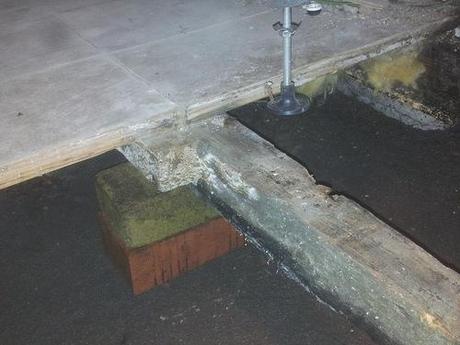
Old Joist.
Going back in time around 16 hours; you can see one of the old joists running out from under the floor supporting the bath…
Before we put a saw to anything more than an old floorboard, we have to support the remainders of the existing joists with a couple of bricks and wooden spacers (packers) I cut on the bandsaw. Fortunately, there was just the right number of bricks out behind the garden shed!
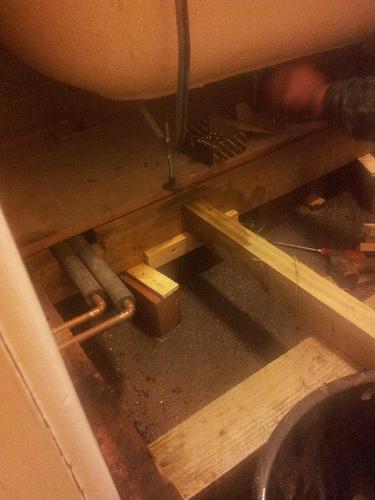
Trimming joist.
So, each joist was then trimmed flush with the edge of the flooring before fitting a length of 4x2in to the sawn and re-treated ends to act as a trimming joists (it might even be a trimmer – those two always confused me!). You’ll note that it was notched to fit around the two copper pipes and, from then, the pressure-treated 3x2ins could be screwed in to place. My dad also decided to fit strips of 2x1in underneath to help support the load… In my opinion, it doesn’t do anything more than simplify the task of keeping the joists flush with one another.
After everything was finished and refitted back in place, I decide to take a peak inside to check that all the leaks had ceased…
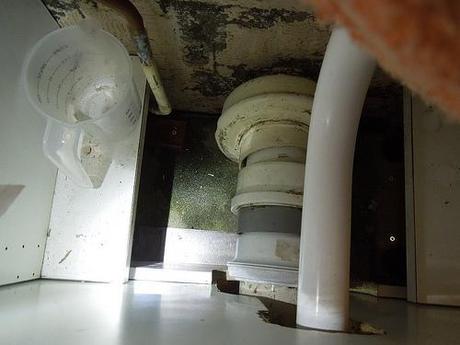
STILL leaking?!?
That was when I noticed a fresh puddle down inside; sitting on the brand-new chipboard floor! I thought it was coming from that narrow pipe (feed?) that you can just see to the left of the soil pipe. My dad insists it’s an issue of condensation (lack of ventilation, with the ill-fitting cistern lid) and so, his solution was, quite literally, to chuck a towel over it…

“Chuck a towel over it…”
Like it or not (I certainly don’t), it has certainly made a difference. He went on about lagging and insulation but, I really don’t see how you could do that here… Why not drill a large hole through the wall for ventilation? We do need more below floor level, anyway.

Filling screw holes with dowels for re-drilling.
Within days of refitting the door, I realised that the screws weren’t holding on to anything, causing the door to bind and stick as it sagged while trying to close or open it. My solution was to drill out each hole with an 8mm bit, before filling these holes with a beech dowel. Re-drilling the pilot holes (3mm) after the glue had dried has given each screw something to bite in to, once again, and the problem is now solved.

You can just see where it’s taken the paint off.
I still don’t understand why or how the door was binding at the top, near the hinge-edge. It’s almost as if it had moved or been repositioned… I check the hinges carefully and even tried swapping them over but, I still couldn’t see what was happening or why… It didn’t look as though the top edge had swollen by several millimetres. There is a larger gap at the bottom of the door (too great for a standard door stop!) but that’s because the finished floor level has also dropped about half an inch.
I’ve had thoughts of removing the door again and refitting the hinges (they’re currently about 7in from the top and 5in up from the bottom – please don’t ask me why!!). Doing that would mean I’d also have to reconsider the positioning of the lock, if I’m also going to attempt to cure the binding issue.
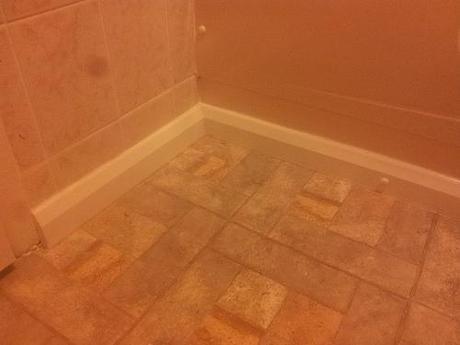
A return of some sort would have been nice…
He did fitting a skirting around the perimeter to tidy it all up and, of course, to hide any unsightly expansion gaps between the wall and floor. It’s simply melamine-faced MDF and, even if he did (possibly) only mitre and not scribe the internal joints, it does look as though he’s seal and painted the exposed MDF ends.
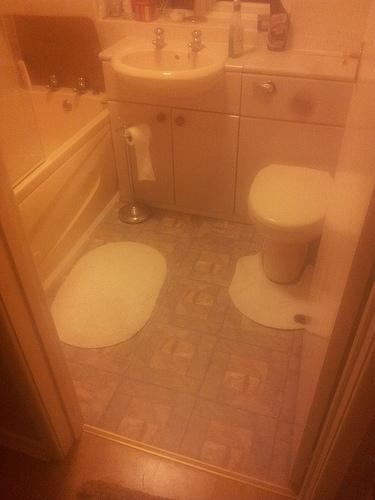
Finished!
I honestly thought I’d taken a finished photo with my camera but, for now at least, I’m afraid you’ll have to settle for another blurry, mis-coloured image captured using my smart phone!
If anyone has any tips on removing or disguising the scratch on a camera lens, please let me know!

This weekend, I need to look at repairing and 6ft square fence panel and replacing the posts on either side. After that, I need to start looking at the Velux windows upstairs.
